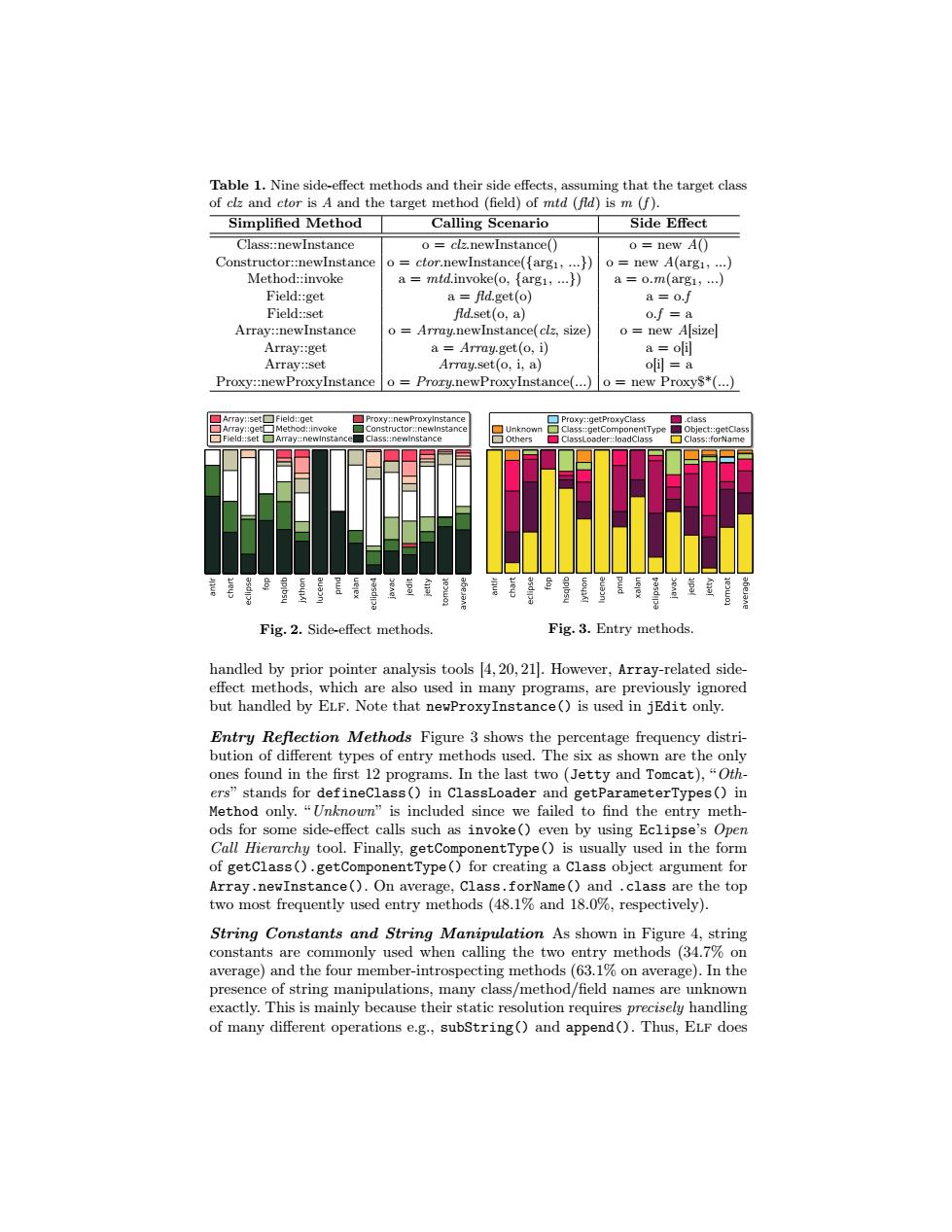正在加载图片...

Table 1.Nine side-effect methods and their side effects.assuming that the target class of clz and ctor is A and the target method (field)of mtd (fld)is m (f). Simplified Method Calling Scenario Side Effect Class::newInstance o clz.newInstance() o new A() Constructor:newInstance o=ctor.newInstance(farg1,.}) o=newA(arg1,…) Method:invoke a mtd.invoke(o,{arg1,...]) a=0.m(arg1,…) Field::get a=fd.get(o) a=o.f Field::set fld.set(o,a) o.f=a Array:newInstance o Array.newInstance(clz.size) o new Asize Array::get a Array.get(o,i) a=o Array::set Array.set(o,i,a)】 ofil =a Proxy:newProxyInstance o Prory.newProxyInstance(... o=new Proxy*(...) oxy..ge ne Other Fig.2.Side-effect methods Fig.3.Entry methods handled by prior pointer analysis tools 4,20,21].However,Array-related side- effect methods,which are also used in many programs,are previously ignored but handled by ELF.Note that newProxyInstance()is used in jEdit only. Entry Reflection Methods Figure 3 shows the percentage frequency distri- bution of different types of entry methods used.The six as shown are the only ones found in the first 12 programs.In the last two (Jetty and Tomcat),"Oth- ers"stands for defineClass()in ClassLoader and getParameterTypes()in Method only."Unknown"is included since we failed to find the entry meth- ods for some side-effect calls such as invoke()even by using Eclipse's Open Call Hierarchy tool.Finally,getComponentType()is usually used in the form of getclass().getComponentType()for creating a Class object argument for Array.newInstance().On average,Class.forName()and.class are the top two most frequently used entry methods (48.1%and 18.0%,respectively). String Constants and String Manipulation As shown in Figure 4,string constants are commonly used when calling the two entry methods (34.7%on average)and the four member-introspecting methods(63.1%on average).In the presence of string manipulations,many class/method/field names are unknown exactly.This is mainly because their static resolution requires precisely handling of many different operations e.g.,subString()and append().Thus,ELF doesTable 1. Nine side-effect methods and their side effects, assuming that the target class of clz and ctor is A and the target method (field) of mtd (fld) is m (f ). Simplified Method Calling Scenario Side Effect Class::newInstance o = clz.newInstance() o = new A() Constructor::newInstance o = ctor.newInstance({arg1, ...}) o = new A(arg1, ...) Method::invoke a = mtd.invoke(o, {arg1, ...}) a = o.m(arg1, ...) Field::get a = fld.get(o) a = o.f Field::set fld.set(o, a) o.f = a Array::newInstance o = Array.newInstance(clz, size) o = new A[size] Array::get a = Array.get(o, i) a = o[i] Array::set Array.set(o, i, a) o[i] = a Proxy::newProxyInstance o = Proxy.newProxyInstance(...) o = new Proxy$*(...) antlr chart eclipse fop hsqldb jython lucene pmd xalan eclipse4 javac jedit jetty tomcat average Array::set Array::get Field::set Field::get Method::invoke Array::newInstance Proxy::newProxyInstance Constructor::newInstance Class::newInstance Fig. 2. Side-effect methods. antlr chart eclipse fop hsqldb jython lucene pmd xalan eclipse4 javac jedit jetty tomcat average Unknown Others Proxy::getProxyClass Class::getComponentType ClassLoader::loadClass .class Object::getClass Class::forName Fig. 3. Entry methods. handled by prior pointer analysis tools [4, 20, 21]. However, Array-related sideeffect methods, which are also used in many programs, are previously ignored but handled by Elf. Note that newProxyInstance() is used in jEdit only. Entry Reflection Methods Figure 3 shows the percentage frequency distribution of different types of entry methods used. The six as shown are the only ones found in the first 12 programs. In the last two (Jetty and Tomcat), “Others” stands for defineClass() in ClassLoader and getParameterTypes() in Method only. “Unknown” is included since we failed to find the entry methods for some side-effect calls such as invoke() even by using Eclipse’s Open Call Hierarchy tool. Finally, getComponentType() is usually used in the form of getClass().getComponentType() for creating a Class object argument for Array.newInstance(). On average, Class.forName() and .class are the top two most frequently used entry methods (48.1% and 18.0%, respectively). String Constants and String Manipulation As shown in Figure 4, string constants are commonly used when calling the two entry methods (34.7% on average) and the four member-introspecting methods (63.1% on average). In the presence of string manipulations, many class/method/field names are unknown exactly. This is mainly because their static resolution requires precisely handling of many different operations e.g., subString() and append(). Thus, Elf does